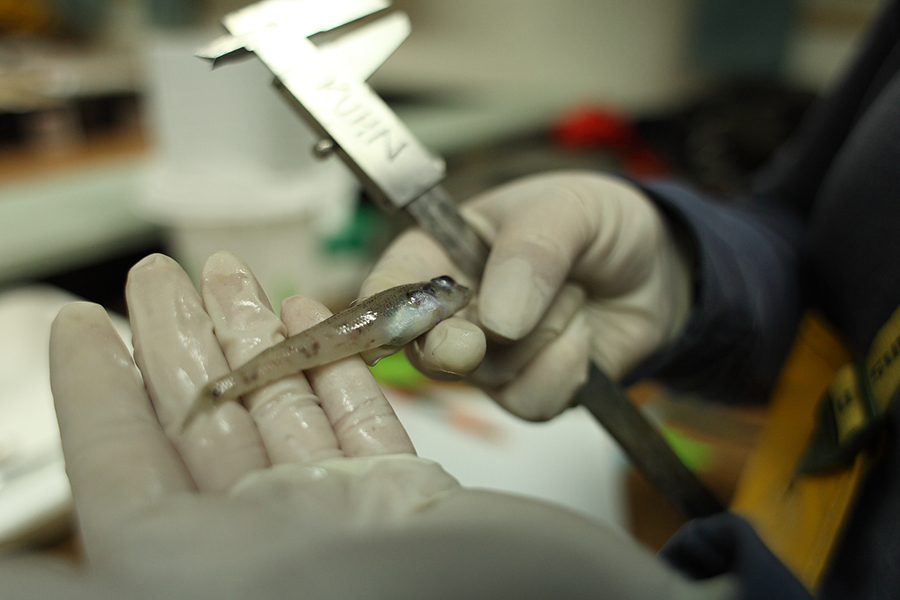Key Antarctic fish species declining due to climate changeFuture warming could disrupt the Southern Ocean ecosystemPosted August 22, 2022
New research finds populations of Antarctic silverfish along the West Antarctic Peninsula are plummeting due to warming temperatures and the loss of sea ice caused by climate change. The Antarctic Peninsula is one of the fastest-warming regions on the planet. Sea ice typically forms along the peninsula in the austral winter and melts the following spring. Because of climate change, there’s less sea ice around the peninsula and the ice that forms now only lasts on average for about four months, when it traditionally lasted for six or more months. Antarctic silverfish are a vital food for penguins, seals, and seabirds that live along the Antarctic Peninsula continental shelf. The fish lay their eggs within the sea ice, which then becomes a critical shelter for newly-hatched fish larvae. A recent study finds that warming ocean water and the reduction in sea ice seen over the past several decades has resulted in less spawning area available for Antarctic silverfish, so fewer eggs hatch and survive to adulthood each season. The findings suggest Antarctic silverfish can only survive in a narrow range of ocean temperatures and the species could disappear entirely from the West Antarctic Peninsula as the climate continues to warm. The effects of losing Antarctic silverfish would ripple throughout the marine food web, according to the study authors. Antarctic silverfish are a keystone species in the ecosystem of the Southern Ocean and if they decline, there would be less food for penguins, seals, seabirds, and other fish that call the peninsula home. “When people think of climate change in Antarctica, the first thing that jumps to their minds are penguins and seals and whales, but it's important to keep in mind the things that those animals eat,” said Andrew Corso, a PhD candidate at the Virginia Institute of Marine Science and lead author of the new study. “Antarctic silverfish are important for Adélie penguins’ fledgling success. So we're talking about the ability of penguin chicks to fledge and survive in the long term, and they can rely on these Antarctic silverfish to do that successfully.” Accidental sample collectionAntarctic silverfish are a sardine-sized species of fish known as notothenioids or cod icefish. These fish carry antifreeze proteins in their blood and body fluids so they can survive in the frigid waters around Antarctica. But that evolutionary advantage makes it difficult for them to adapt to warming oceans. Biologists have long suspected that climate change would affect Antarctic silverfish, but they didn’t have much data available to study this species populations over a long period of time. Scientists even noticed silverfish had disappeared in one area of the peninsula near Palmer Station back in 2010. But during his graduate work, Corso came across samples of silverfish that had been collected as bycatch for the Long-Term Ecological Research program at Palmer Station. LTER researchers collect and study krill, tiny crustaceans that form the base of the marine food web, and larval silverfish often get caught in their nets. Luckily, the silverfish specimens caught since 1993 had been preserved and stored at the Nunnally Ichthyology Collection at the Virginia Institute of Marine Science where Corso is studying. Corso went through the archived silverfish samples and counted how many juveniles, or larvae, there were each season from 1993 to 2017. He then compared the abundance of fish larvae to various environmental factors like ocean temperature and sea ice cover to see if there was any correlation between them. He found that as ocean temperatures have warmed and sea ice has declined over that 25-year period, fewer silverfish larvae are found in the area. Part of the reason could be that sea ice provides cover for the eggs and protects them from predators. So as the climate of the Antarctic Peninsula has warmed, the adaptations silverfish have evolved to survive in super-cold water are now working against them. “They have a suite of adaptations that allow them to live in these cold waters in the high Antarctic environment, and it makes them less able to deal with temperatures that are warming quickly,” Corso said. As the climate continues to warm, silverfish could disappear altogether from the peninsula region, according to the study. Antarctic silverfish evolved nearly 20 million years ago and have survived through periods of extreme warming and cooling, but temperatures might be rising fast enough to outpace their evolution. “They should have what we call evolutionary plasticity, or the ability to partially cope with rising and falling temperatures, rising and falling sea ice concentrations,” Corso said. “But there's this idea of a cliff edge, where at some reduction in sea ice and warming temperatures, their populations in this region of Antarctica are just not going to be able to continue sustaining themselves. And for the northern part of the western Antarctic Peninsula, we feel that it's very close to that point, if not already there.” This research is supported by the National Science Foundation, which manages the U.S. Antarctic Program. NSF-funded research in this story: Hugh Ducklow, Lamont-Doherty Earth Observatory, award 1440435; Eric Hilton, Virginia Institute of Marine Science, award 1349327; and Oscar Schofield, Rutgers University, award 2026045. |
"News about the USAP, the Ice, and the People"



For USAP Participants |
For The Public |
For Researchers and EducatorsContact UsU.S. National Science FoundationOffice of Polar Programs Geosciences Directorate 2415 Eisenhower Avenue, Suite W7100 Alexandria, VA 22314 Sign up for the NSF Office of Polar Programs newsletter and events. Feedback Form |


